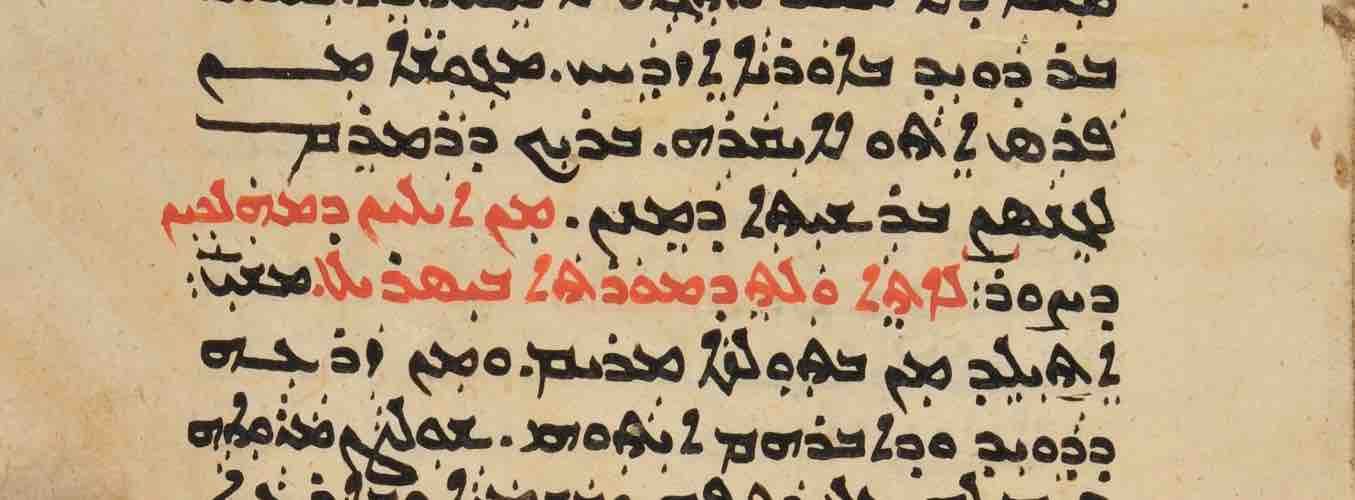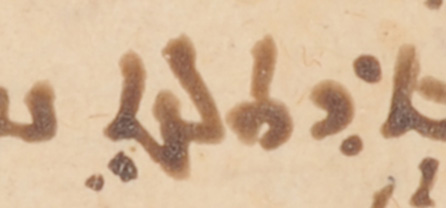Lesson
Syriac Scripts - East Syriac

Description
A development of Estrangela used in East Syriac tradition manuscripts, often with complex vocalization and other diacritical marks.
Overview
East Syriac script aligns more closely with Estrangela than Serto, but of course the dividing lines are not quite as delimiting as might first seem. The characteristics that distinguish East Syriac from Estrangela (or Serto) are more pronounced in printed works than in manuscripts, but what about the latter? Letters that have especially typical East Syriac forms include:
- ālap: this letter shows some variety: it may be similar to the Estrangela type, but generally with a shorter lower part; it consists on the left of a line coming only slightly up from the baseline, joins the long angled part and ends with a slight backturn at the bottom hanging below the line; alternatively, it is often merely a curved, roughly vertical line, with a large serif at the top and sometimes angling back to the right at the top
- gāmal: shape may be similar to that of Estrangela, but often simply an angled stroke hanging well below the line; when joined to previous letter, the baseline often (not always) bisects the gāmal, unlike in Estrangela
- dālat / rēš: round on top and with a horizontal bar sitting on the line
- hē: the vertical on the right joins the loop from the top of that line, not lower down (as is typical in Serto)
- zayn: a vertical line thicker at the top that reaches only slightly below the line, if at all
- final kāp: may have an extended (compared with Estrangela) top part on the left; another type goes from the top right and down seemingly without lifting the pen
- mim: is generally round, as in Serto, not the angled type more common in Estrangela manuscripts, except often in final form, where it is boxy
- semkat: like a left-leaning θ (i.e. the left side sits notably higher than the right), also seen in some Estrangela manuscripts
- tāw: a tall triangular shape, partly open or barely closed at the bottom right, but with a curved bottom line reaching back to the right from the left leg of the triangle (in some manuscripts, however, it is similar to an Estrangela form with a completely closed loop, or rather a mere line, at the bottom left)
In addition, there is a special tāw-ālap ligature (especially common, of course, at the end of feminine emphatic, singular and plural, forms) that is a particular East Syriac phenomenon. It is a short v shape that hangs below the line and then joins a straight ālap on the left. This ligature is, however, not always used. Here is an example from CCM 65, f. 50v (da-tlātā):
 Mardin, Chaldean Cathedral, CCM 65, f. 50vb, l. 14. All rights reserved. Image provided by HMML.
Mardin, Chaldean Cathedral, CCM 65, f. 50vb, l. 14. All rights reserved. Image provided by HMML.
But, as we have already emphasized, forms that may well especially typify East Syriac are not precluded from appearing in otherwise predominantly Estrangela manuscripts, just as forms that may be called typically Serto appear in Estrangela manuscripts.
Here follow several examples from the tenth century onward, with some notable characteristics of each indicated.
Example 1 - 10th/11th-century manuscripts
Alqosh, DCA 144, f. 11v (1273 AG = 961/2 CE)
Gospels
Alqosh, Chaldean Diocese, DCA 144, f. 11v. All rights reserved. Image provided by HMML.
| ālap | of the Estrangela type |
| dālat / rēš | often like the common Serto type (i.e. without much of a base at the bottom) |
| ṭēt | when final, has a round bottom part |
| mim | round, even in final form, but the left arm comes more from the side than the bottom of the loop |
| nun | in final form either a very modest sublinear angled stroke with a right-curving hook at the bottom, or the longer almost horizontal type |
| tāw | in both types, the Estrangela and the triangle |
Mosul, CAM MIC 1, f. 8v (10th/11th century)
Ḥudrā
Mosul, Chaldean Archdiocese, Church of Mar Ishaya, CAM MIC 1, f. 8v. All rights reserved. Image provided by HMML.
| ālap | of both types |
| gāmal | decidedly East Syriac in shape |
| dālat / rēš | of the Serto type |
| mim | not round, but boxy |
| semkat | not the left-leaning θ, but in a form similar to Estrangela, although with little height difference between the two loops, both of which are slightly pointed |
| pē | relatively tall |
| šin | not the usual t-shape, but like an inverted triangle sitting on the baseline |
| tāw | in both types, the triangular form at word-end |
This heavily rubricated manuscript is difficult to read in places due to water damage, fading, or other marks of use and age.
Example 2 - 13th/14th-century manuscripts
Mardin, CCM 115, f. 7v (dated 1287/8)
Ḥudrā
Mardin, Chaldean Cathedral, CCM 115, f. 7v. All rights reserved. Image provided by HMML.
| ālap | in both types |
| dālat / rēš | of the usual Serto type |
| gāmal | tending more toward the Estrangela shape, i.e. the letter has some angle at the bottom and is not merely a long stroke bisecting the baseline |
| ṭēt | either angled or round at the bottom |
| kāp | in final form of the type apparently written without lifting the pen (i.e. it goes from the baseline slightly up, then down and left, then in a descender back to the right, ending in a curve |
| tāw | of the triangular shape; the tāw-ālap ligature appears |
Mardin, CCM 65, f. 50v (13th/14th century)
Gospel Lectionary with Commentary
Mardin, Chaldean Cathedral, CCM 65, f. 50v. All rights reserved. Image provided by HMML.
| ālap | always of the simple vertical line variety |
| dālat / rēš | of the Serto type |
| semkat | the left-leaning θ type |
| tāw | in both forms that often appear in East Syriac manuscripts, but there is a third type, shaped like a v that hangs below the line (see, for example, the word hwt in the last line of f. 50v, and qrbt four lines from the bottom, but contrast sgdt two lines from the bottom) this v-shape is like that of the tāw-ālap ligature without an ālap component |
This bilingual Syriac-Arabic manuscript is not easily classified according to a simple Estrangela-Serto-East Syriac paradigm. The only distinctive East Syriac forms are the gāmal, the semkat and the tāw-ālap ligature. (The vowels here are East Syriac.)
Mardin, CCM 419, f. 4v (dated 1395)
Gewargis Warda and Khamis bar Qardahe
Mardin, Chaldean Cathedral, CCM 419, f. 4v-5r. All rights reserved. Image provided by HMML.
This manuscript in general offers a very typical kind of East Syriac. It also shows both kinds of tāw : the form similar to the Estrangela-type (the more common here), and the triangular shaped tāw. Whether or not tāw is attached to the previous letter has no effect on the chosen shape. In addition, the ṭēt often has a sharp lower part, but with a preceding joined letter it sometimes appears with a round lower part, as in Serto.
Example 3 - 15th/16th-century manuscripts
Tell Kaif, QAACT 9, f. 2r (15th century)
Gospel Lectionary
Tell Kaif, Qalb Al-Aqdas Chaldean Church, QACCT 9, f. 2r. All rights reserved. Image provided by HMML.
| ālap | in both the Estrangela form (with a notable upward curve on the top part) and in the usual East Syriac type |
| mim | of the typically East Syriac round type, but when final it is angled |
| tāw | not the triangular type, but of the form closer to that in Estrangela; the tāw-ālap ligature is present |
Mosul, CAM 1, f. 3v (dated 1598)
Burial Rite for Priests and Deacons
Mosul, Chaldean Archdiocese, CAM 1, f. 3v. All rights reserved. Image provided by HMML.
| ālap | in both kinds: the full Estrangela form (especially at line-end) and the more horizontal East Syriac kind |
| ṭēt | as in CCM 419, when joined to a previous letter, may have a round lower part |
| kāp | in final form of two kinds: that similar to the Estrangela type and one in which the pen is not lifted but rises slightly from the baseline and then descends and curves back to the right (both appear in f. 3v, line 3) |
| mim | when final, has a more angular body |
| tāw | much more often of the triangular shape; the tāw-ālap ligature is present |
Tell Kaif, QAACT 10, f. 4r (16th century)
Gospel Lectionary
Tell Kaif, Qalb Al-Aqdas Chaldean Church, QACCT 10, f. 4r. All rights reserved. Image provided by HMML.
| ālap | of the Estrangela type |
| tāw | also of the Estrangela type |
Mardin, CCM 71, f. 59v (dated 1536)
Epistle Lectionary
Mardin, Chaldean Cathedral, CCM 71, f. 59v. All rights reserved. Image provided by HMML.
| ālap | of the Estrangela type, with a strong curve at the top line |
| dālat / rēš | very round, like hē and kāp |
| mim | in final form, angular, as often, with a straight descender angled a bit to the left |
| tāw | of the Estrangela type |
This manuscript has a loose, more flowing character overall than is typical for East Syriac manuscripts. It shows a fluid, less calligraphic hand that is nevertheless quite legible.
Example 4 - 17th/18th-century manuscripts
Mosul, CAM 3, f. 2r (dated 1685)
Gazzā
Mosul, Chaldean Archdiocese, CAM 3, f. 2r. All rights reserved. Image provided by HMML.
| ālap | usually of the vertical line type, but sometimes closer to the Estrangela type |
| kāp | both kinds of final form CAM 1 the word ʾyk, for example, is written with one kind at lines 3 and 12, and with the other four lines from the bottom on the same folio the word lk is written with both kinds at line 18 |
| pē | rather tall |
| tāw | of the triangular type the tāw-ālap ligature is present |
This manuscript exemplifies the thick, angular script that is similar to common East Syriac typefaces, such as those in Paul Bedjan’s numerous text editions.
Mardin, CCM 23, f. 27r (dated 1796)
Eliya of Nisibis, Syriac Grammar
Mardin, Chaldean Cathedral, CCM 23, f. 27r. All rights reserved. Image provided by HMML.
| ālap | in both forms, the Estrangela type with a conspicuous curve at the top |
| hē | the line connecting the circle and the vertical on the right lower than the top of that vertical, i.e. there is a small tip above the right angle |
| semkat | sitting flat or almost flat on the baseline, i.e. it is not really a left-leaning θ |
| tāw | usually of the triangular type |
| there is a tāw-ālap ligature, but it is like the mashed together kind in Estrangela, not the typical East Syriac type (see examples on lines 4, 3, and 2 from the bottom, but contrast two places in line 6 from the bottom, where the triangular tāw is followed by the Estrangela ālap without any contact between the letters) |
Mosul, DFM 13, f. 45r (dated 1723)
Gospel Lectionary
Mosul, Dominican Friars, DFM 13, f. 45r. All rights reserved. Image provided by HMML.
| ālap | of the Estrangela type |
| mim | in final form, angular, not round, and with a very thin descender curving back to the right |
| tāw | also of the Estrangela type |
Ready to transcribe?
Try your hand at transcribing East Syriac scripts